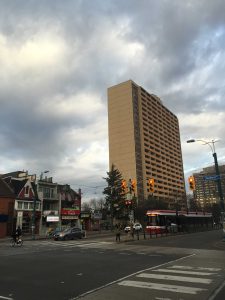Residents decry loss of green space and heritage impacts

PHOTO BY BRIAN BURCHELL/GLEANE NEWS: Uno Prii designed 666 Spadina Ave., which is listed on the city’s inventory of Heritage Properties. The property owner wants to add an 11-storey building and eight stacked townhouses on the site.
By Brian Burchell
It was billed as a community consultation, but a Nov. 29 meeting on plans to add an 11-storey mixed-use building and eight stacked townhouses to the north and south of the existing 25-storey tower at 666 Spadina Ave. was more about airing grievances than anything else. Those in attendance refused to be appeased and were critical of the proposal’s potential impacts on the heritage site and local green space.
In fact, it was a rather fractious affair.
The site is in itself an anomaly.
“There was a vision here in 1969, and I think it deserves respect…50 years later”—Bob Bernett, Sussex Avenue resident
As City of Toronto planner Liora Freedman explained, the site’s zoning is tailored to apartment building, and exceeds the residential height limit of 12 metres. It’s believed this was approved at the time the building was built because the original application included so much green space, a hallmark of Uno Prii, the architect responsible for this and many other residential high rises in the Annex, many of which are listed the city’s Inventory of Heritage Properties.
“The 1969 site-specific zoning allowed for the building to take up 30 per cent of the site and [leave] the remaining 70 per cent [as] open space,” said Freedman, adding that the property abuts a Harbord Village Conservation District on the west side, and as such, must transition in a manner that respects that low-rise residential neighbourhood.
Yet critics argued that just because the space exits for infill doesn’t mean it should be filled.
“There was a vision here in 1969, and I think it deserves respect…50 years later,” said Sussex Avenue resident Bob Bernett. “The developer got a gift when this was first developed; he got extra height and density because he left all this green space around it. The idea that we can get rid of all this parkland now does not wash with me.”
Robert Street resident Norman Track took issue with the adequacy of the existing public infrastructure to accommodate such heavy intensification, noting that “the sanitary sewers in Toronto are of 1908 vintage and they are leaking”, and that despite “all this influx of people [there are] no new hospitals”. He also expressed concern, after the power outages the Annex has experienced this year, about the ability of the hydro network to support more growth here given that “according to Toronto Hydro itself [in April 2016] 25 per cent of its infrastructure is outdated”.
Joe Cressy (Ward 20, Trinity-Spadina) acknowledged the power outages that occurred over the summer, but said they were not capacity related.
“[These were] caused by inclement weather and if you can believe it squirrels, and Hydro has prepared a report confirming this,” said Cressy. “The load capacity for downtown Toronto is not only stable but is planned for the future…. A new power station, [the Copeland Transformer Station], down at the Round House Park, is coming on line next year. It is a multi-billion-dollar facility that is designed to accommodate growth.”
The councillor reviewed the extensive “pre-application engagement” that the property owner has undertaken with respect to 666 Spadina Ave., and said the application incorporates significant changes since the last community consultation meeting.
“The plan that we ended up submitting, in response to the feedback we heard at the last consultation included increasing the set-back from [Sussex Mews] lane [from 6 to 10.5 metres], increasing the separation distance from the existing building and the new proposed building, and relocating the garbage enclosure away from the lane,” explained Mansoor Kazerouni of Page + Steele IBI Group Architects. Although the height of the mid-rise building to the south remains at 11 storeys, the application to the city exists entirely within the 45 degree solar angle required in the current planning rules.
The architect also described a provision for the privately-owned publicly accessible space on the west side of the property (the east side of Sussex Mews), which occupies 450 square metres (roughly 5,000 square feet). A glass vestibule has been added in this articulation of the proposal connecting the existing high-rise with the new 11 storey building which Kazerouni says will “be publicly accessible 24/7 and aid in wind mitigation”.
“The existing slab style building has an inherent problem with wind, since it is oriented against the prevailing wind which then must down wash around and flow around the adjacent streets or properties,” said Stephen Pollack of Theakston Environmental, which was retained by the developer to do wind studies on the property. “The proposed townhouses on the north side and stepped 11-storey building on the south side will deflect these winds.”
Several speakers were not swayed by the wind mitigation argument and decried the loss of open space that additional buildings would occupy. Or as Bernett put it, “I am sorry. If we want to deal with wind issues we can plant some coniferous trees there.”
READ MORE:
NEWS: Preventing a wall of towers (October 2016)
CHATTER: Two new rezoning applications submitted to city (September 2016)
NEWS: Tall tower before OMB, as city battles back with block study (August 2016)
NEWS: Planning for the future (May 2016)
DEVELOPINGS: Annual review reflects tension between community activism and OMB (March 2016)
